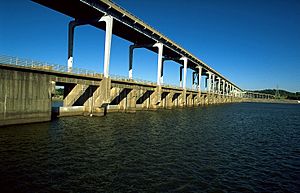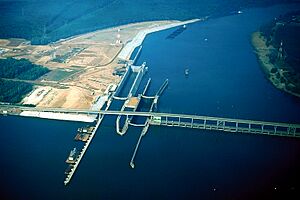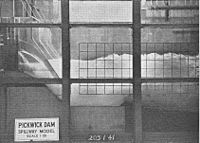Pickwick Landing Dam facts for kids
Quick facts for kids Pickwick Landing Dam |
|
|---|---|

Pickwick Landing Dam from upstream
|
|
| Official name | Pickwick Landing Dam |
| Location | Pickwick Dam, Hardin County, Tennessee, United States |
| Coordinates | 35°03′50″N 88°14′50″W / 35.06389°N 88.24722°W |
| Construction began | March 1935 |
| Opening date | May 8, 1938 |
| Operator(s) | Tennessee Valley Authority |
| Dam and spillways | |
| Impounds | Tennessee River |
| Height | 113 ft (34 m) |
| Length | 7,715 ft (2,352 m) |
| Reservoir | |
| Creates | Pickwick Lake |
The Pickwick Landing Dam is a huge dam on the Tennessee River in Hardin County, Tennessee. It creates electricity from water power. The Tennessee Valley Authority (TVA) built this dam in the 1930s. It was part of a big plan to help the area grow. The dam helps boats travel easily along the river. It also created a large lake called Pickwick Lake. This lake covers about 43,100-acre (17,400 ha) of water. The water flowing out of Pickwick Dam becomes part of Kentucky Lake.
The dam got its name from a community that used to be nearby. This community was named after a character from a book by Charles Dickens, called The Pickwick Papers.
Contents
Where is Pickwick Landing Dam Located?
Pickwick Landing Dam is located about 207 miles (333 km) from where the Tennessee River flows into another river. It's just a few miles north of where Tennessee, Alabama, and Mississippi meet. This area is a natural border between the hills of the Western Highland Rim and the flatlands of West Tennessee.
Most of the land south of the dam is part of Pickwick Landing State Park. Shiloh National Military Park is also a few miles north. Pickwick Lake stretches for about 53 miles (85 km) up to Wilson Dam in Muscle Shoals, Alabama. The lake covers parts of Hardin County in Tennessee, Lauderdale and Colbert counties in Alabama, and Tishomingo County in Mississippi. The area around the dam is not very crowded. The closest town is Counce, Tennessee, about 2 miles southwest. Tennessee State Route 128 goes right over the top of the dam. This road connects the area to Savannah to the north.
How Big and Powerful is the Dam?
Pickwick Landing Dam is 113 feet (34 m) tall and 7,715 feet (2,352 m) long. It can produce 240,200 kilowatts of electricity. The dam has a special section called a spillway with 22 openings. These openings can release a lot of water, up to 650,000 cubic feet per second (18,000 m3/s).
Pickwick Lake has 496 miles (798 km) of shoreline and covers 43,100 acres (17,400 ha) of water. It can hold a huge amount of water, about 417,700 acre-feet (515,200,000 m3), to help prevent floods. The dam also has two special "locks" for boats. One lock is 110 by 1,000 feet (34 by 305 m) and the other is 110 by 600 feet (34 by 183 m). These locks can raise and lower boats up to 63 feet (19 m) between Pickwick Lake and Kentucky Lake.
Why Was Pickwick Dam Built?
For a long time, in the 1800s, there were fast-moving river sections called the Muscle Shoals in northern Alabama. These shoals made it very hard for boats to travel along the Tennessee River. They basically cut off the upper parts of the river, like Knoxville and Chattanooga, from other major waterways.
The U.S. Army Corps of Engineers built Wilson Dam in the 1920s. Then, the Tennessee Valley Authority (TVA) built Wheeler Dam in the 1930s. These dams helped flood a large part of the shoals. But there were still big problems for boats between Riverton and Florence.
As Wheeler Dam was almost finished in 1935, TVA knew they needed a third dam. This new dam would connect the lakes created by Wilson and Wheeler dams with the lower part of the river. The U.S. Army Corps of Engineers had studied the area in the 1920s and suggested building a dam at Pickwick Landing. So, the Pickwick Landing project was approved on November 19, 1934. Work on the dam began in March 1935.
Building the Pickwick Landing Dam
To build Pickwick Landing Dam and its lake, TVA had to buy about 63,700 acres (25,800 ha) of land. They also had to clear 12,590 acres (5,090 ha) of land. Many people had to move: 506 families, 407 graves, and 70 miles (110 km) of roads were relocated. Parts of the towns of Riverton and Waterloo, Alabama were flooded.
The people of Waterloo wanted TVA to buy their whole town. They said the new lake would make their property worthless. But TVA said no, because their studies showed the lake wouldn't hurt the town's economy much. The original machines that make electricity at Pickwick Landing Dam were very special. They were some of the biggest "propeller-type" turbines in the world when they were installed.
Pickwick Landing Dam was finished and its gates were closed on February 8, 1938. However, some digging work continued until 1941. The first generator started making electricity in August 1938. The boat lock was designed by the Corps of Engineers. Its 63-foot (19 m) lift was one of the highest in the world when it started working on February 19, 1938. Building Pickwick Landing Dam cost a little over $45 million.




